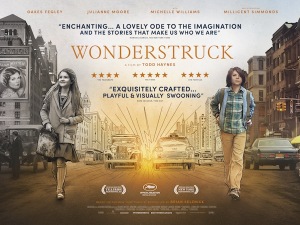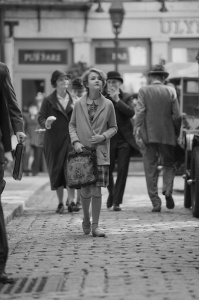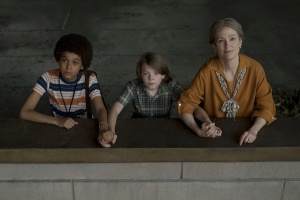Wonders beyond words
by Mark Reynolds A conversation with Todd Haynes, Brian Selznick, Oakes Fegley and Jaden Michael.
A conversation with Todd Haynes, Brian Selznick, Oakes Fegley and Jaden Michael.
Todd Haynes’ latest film Wonderstruck is adapted from Brian Selznick’s part-graphic, part-prose children’s novel about a mysterious connection in New York City between two deaf children set 50 years apart. In 1927 Rose (Millicent Simmonds) is the estranged daughter of silent movie star Lillian Mayhew (Julianne Moore), who travels alone from Jersey to Manhattan to witness her return to theatre; and in 1977 Ben (Oakes Fegley), who has just lost his hearing in a freak accident, journeys there from Gunflint, Minnesota in a quest to learn his father’s identity. Once there he befriends Jamie (Jaden Michael), a smart, helpful kid whose father works at the Museum of Natural History, where he hangs out and holes up Ben in a secret storage room. A 20th-century fairy tale packed with unlikely coincidences and discoveries, it sweeps you along with emotional depth and immersive awe. It is a departure for the director on a number of levels.
It asks of the cinematic language to step up and carry the experience in every possible way… I just thought this could be such a special thing for kids that they’ve never seen anything like before.”
“What attracted me was it was a double-period film that is structured like a mystery, a genre I’ve never really tackled, but it’s a mystery in which the intercutting between the two stories keeps restating the enigma, the question why are these two stories joined, what’s linking them?” says Haynes. “It asks of the cinematic language to step up and carry the experience in every possible way: music, cinematography, production design, costumes, all of it, and the editorial language at the core. I just thought this could be such a special thing for kids that they’ve never seen anything like before.”
After having been involved around the set on Martin Scorsese’s filming of his earlier book The Invention of Hugo Cabret – released as Hugo – Selznick was keen to try his hand at adapting, and having established a rapport with Hugo writer John Logan, he found himself mentored by one of the best in the business.
“John said he would take me under his wing and give me notes,” says Selznick. “I mean, I didn’t even know which screenwriting program to download, so he told me what to use and gave me some really insightful notes all the way through the process. It was sort of like having a masterclass in screenwriting, as I was writing my first screenplay.”
 He soon decided he wanted to split the action between a black-and-white silent movie-style segment from 1927, and a colour segment with the look and feel of New York in 1977. Before shooting, neither the director nor the writer had fully grasped how much of the colour story would also turn out to be dialogue-free.
He soon decided he wanted to split the action between a black-and-white silent movie-style segment from 1927, and a colour segment with the look and feel of New York in 1977. Before shooting, neither the director nor the writer had fully grasped how much of the colour story would also turn out to be dialogue-free.
“Of course the black-and-white’s all silent,” says Haynes, “but it wasn’t until I watched the first cut of the movie that I was struck by how silent the colour portion is.”
“There’s part of the movie that lasts about an hour where there’s practically zero dialogue,” adds Selznick. “I had written it, and I didn’t realise it was going to be that long or that it was going to be that much, so it was a surprise. But it was really about the narratives progressing in this visual way. Then of course the movie also offers all of this great opportunity with sound design and music.”
Composer Carter Burwell’s melodic score weaves the two stories together, interspersed with 1970s grooves from the likes of David Bowie, The Sweet, Rose Royce and Esther Phillips (the latter’s ‘All the Way Down’ dropping the boy Ben and the audience into the thick of the bustling streets around a fabulously seedy and dilapidated Port Authority bus station). Burwell worked with Haynes on Carol and Velvet Goldmine, as well as the TV adaptation of Mildred Pierce, and other frequent collaborators include costume designer Sandy Powell, DoP Ed Lachman, editor Affonso Gonçalves, production designer Mark Friedberg – and Julianne Moore.
“This is the closest two movies I’ve made in succession, from Carol to Wonderstruck,” says Haynes, “and if we hadn’t embarked on a serious awards campaign on Carol, it wouldn’t have taken me quite so far into 2016, where basically from as soon as I finished at the end of February, I went right to New York, and because of Julianne’s schedule we had just two months for pre-production on Wonderstruck – and it’s such a complicated movie. I would have liked another month, but I had such an expert team. I just had all my favourite folks around me, and in a way our seats were still warm from working on the last movie, so the energy was still in the air.”
In typical Todd Haynes fashion, every scene captures its era down to the minutest detail, and the casting of the extras for the 1970s scenes threw up a very particular challenge.
“We had to find a different kind of body that they don’t really produce anymore,” says Haynes, “and they had to dress the way people dressed in the Seventies, meaning even not wearing underwear, and what polyester clothes do to your private parts when you’re not wearing underwear… But it was just so great because they all really entered into the spirit of what they were doing, and you see that on the screen.”
Millicent is a whole other level of astonishment and discovery. She’d never acted before, but she has an uncanny understanding of the medium of film and what the camera picks up that you can’t teach.”
 Haynes and Selznick are full of praise for what the three child actors, particularly deaf newcomer Millicent Simmonds (also now in cinemas in the eerily affecting A Quiet Place), brought to their roles.
Haynes and Selznick are full of praise for what the three child actors, particularly deaf newcomer Millicent Simmonds (also now in cinemas in the eerily affecting A Quiet Place), brought to their roles.
“The boys are really special and really bright, and they had some experience acting, but Millicent is a whole other level of astonishment and discovery,” says Haynes. “She’d never acted before, but she has an uncanny understanding of the medium of film and what the camera picks up that you can’t teach. There’s something innate about the scale of her gestures and her expressions that just really works.”
“I think Ben in the book is a bit more delicate,” adds Brian. “Oakes brings a real vulnerability to it, but he also brings a real sense of strength that I hadn’t seen in the character before. And Jamie is a much more vibrant character than I had originally imagined him to be in the book. Jaden just sparkles onscreen, he really has a shiny personality, but he also has depths and real emotion that I think is very moving. With Millie, maybe in a way she was the closest to what I had imagined Rose being like in the book. Rose’s strength and curiosity and beauty were very much in evidence in Millie from the minute we first saw her audition tapes.
Julianne Moore also plays the grown-up Rose, and there are some wonderfully tender moments between her and Tom Noonan as older siblings, in which she is utterly believable as a woman who has lived with deafness her whole life.
“We wanted to establish a closeness to the deaf community,” says Haynes, “but like any group the deaf community is proud, complicated, divided and diverse, and there are some people who are just like, ‘No! You’ve got to cast a deaf actor in that role!’ So she felt burdened to be sensitive, and really study and surround herself with deaf people for insight and understanding. So that was the very special burden and responsibility that she brought to this.”
Although you’d need a keen eye to spot it, aside from Millie, six deaf actors play hearing people in the silent-movie section. “On the set we had interpreters, deaf actors, hearing actors,” says Selznick. “We had a sign-language class for the crew before the movie began, so everyone knew a little sign language, and the deaf actors felt very welcomed on the set, and many of them said that it was the best experience they ever had on a hearing set.”
Despite having no scenes together, Jaden and Millie bonded closely on the set and after the shoot, when Jaden made a point of learning more about signing. “You’re considered a good signer if you have a lot of facial expressions,” he explains, “so a lot of sign language is emotion. It’s a very visual language.”
Night at the Museum only shot there for one day, for the outside scenes, but we were there for 12 or 13 days, and we were running around the museum until like four in the morning!”
In preparation for the role of Ben, Oakes went on a walking tour of New York with Haynes wearing noise-cancelling headphones. “After I’d gotten the role I went up to see him and to meet some people from the movie,” says Oakes, “and he took me on a walk of New York City with construction earmuff headphones, and then we put in earplugs as well, so it was almost completely silent. He took me on that walk just to see how New York was such a loud city, and you almost don’t even notice it when you’re just walking, but when you have no sound coming in, you’re like, woah! It’s a big hit. It was also a huge bonding experience for me and Todd.”
Jaden immersed himself in music to get into character for Jamie. “While I was doing hair and make-up, I would pop in my earbuds and listen to what he would have been listening to at that time,” he says, “and what was going on in New York City was a lot of punk rock, so I was listening to a lot of stuff like that, just to get into that feel.”
 Both boys thoroughly enjoyed dressing up in garish 1970s fashions. “I loved them!” says Jaden. “I’ve always said either I was supposed to have been born in Tokyo or in the 1970s. I love everything about it, I like the clothing, I like how people do their hair – I mean, look at my hair, it’s basically the same! But I like the colours, I like the differences. It’s a lot more out there.”
Both boys thoroughly enjoyed dressing up in garish 1970s fashions. “I loved them!” says Jaden. “I’ve always said either I was supposed to have been born in Tokyo or in the 1970s. I love everything about it, I like the clothing, I like how people do their hair – I mean, look at my hair, it’s basically the same! But I like the colours, I like the differences. It’s a lot more out there.”
They also relished filming their scenes together in the museum. “Actually we were the longest shoot to shoot there,” says Jaden. “Night at the Museum only shot there for one day, for the outside scenes, but we were there for 12 or 13 days, and we were running around the museum until like four in the morning!”
With Julianne Moore, Oakes also got to walk on the panorama of New York City at Queens Museum, a scale model of the entire city that was installed there for the 1964 World’s Fair.
“That was something very special,” he says. “We were doing something most people aren’t allowed to do, and it was just really cool and something I will remember forever.”
They both have the same passion for museums and learning as their characters. “I love museums,” says Jaden. “I love going back in time and doing research on different characters and different eras, and my character basically lives in a museum and he loves discovering new things.”
“My character also basically lives in a museum,” says Oakes. “In Ben’s room he collects all sorts of awesome things, he has these little action figures and rocks, and models of planets and animals, and pictures of birds, and everything you could ever imagine as a little kid and you would want to collect. I love museums as well, but I think something I really have in common with Ben is he loves outer space and stars and planets, and I’ve always found an interest in outer space and solar systems and galaxies and nebulas and everything.”
The drawings in the book end up serving as a kind of storyboard for elements in the movie, and Todd, like Scorsese, reproduced some of them exactly.”
 Selznick’s first challenge in adapting the book was to make some sharp cuts in the plotting. “In the book the story in the Seventies takes place over a couple of weeks,” he says, “and in the movie it takes place essentially over a single night once they are in New York. Then there are three or four different clues Ben has as to who his father is in the book, and in the movie there’s one, so there were moments like that, but the general arc of the whole story really is the same as it was in the book.
Selznick’s first challenge in adapting the book was to make some sharp cuts in the plotting. “In the book the story in the Seventies takes place over a couple of weeks,” he says, “and in the movie it takes place essentially over a single night once they are in New York. Then there are three or four different clues Ben has as to who his father is in the book, and in the movie there’s one, so there were moments like that, but the general arc of the whole story really is the same as it was in the book.
“It’s like I keep accidentally storyboarding movies,” he reflects. “When I’m making a book I’m not thinking about the possibility of it being adapted for a film, but then once it’s done, and this happened with Hugo too, the drawings end up serving as a kind of storyboard for elements in the movie, and Todd, like Scorsese, reproduced some of my drawings exactly.”
Selznick was introduced to Haynes by Sandy Powell, with whom he’d become friends when she made the period costumes for Hugo, but it was only after the director had finished editing Carol that he finally found time to read the screenplay.
“Then I got a really long email from him about how much he loved it,” recalls Selznick, “and just knowing that I wrote something that he liked was a thrill. He ended by saying he had several other projects that he’s committed to, so he didn’t really know what he could do, but there was something about that email, and something about the passion that he was describing, his love for this story and his connection with these characters, that I said to my husband David, ‘I think Todd’s going to turn down all those other things in order to do Wonderstruck,’ and that’s what happened. Within a couple of weeks I got an email back saying he was going to make it.”
Wonderstruck is released in the UK by StudioCanal. The book is published by Scholastic.
Mark Reynolds is a freelance editor and writer, and a founding editor of Bookanista.
@bookanista

